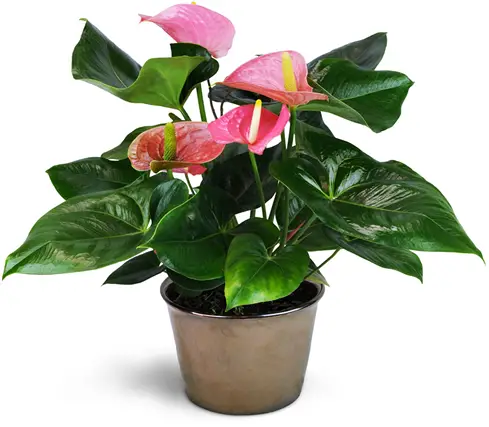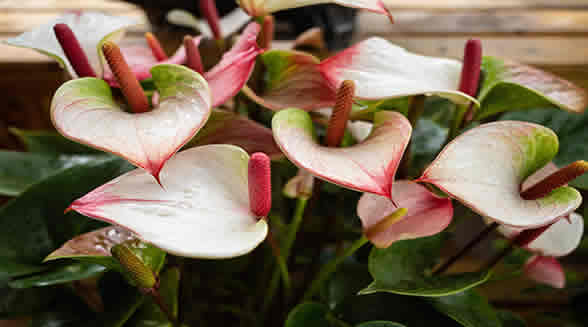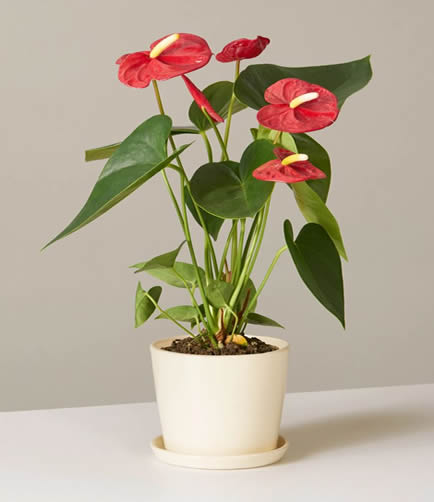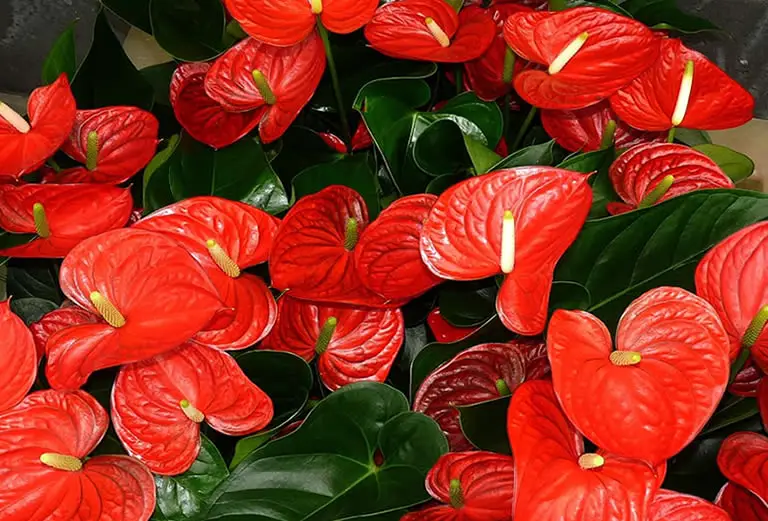Anthuriums are admired for their bright, exotic flowers and glossy green leaves, often blooming year-round when conditions are right. So if your plant looks healthy but refuses to flower, it can be seriously frustrating.
The good news? Your Anthurium is probably just missing one or two key elements in its care routine. These tropical beauties are a bit particular, but once you understand what they need, you can coax those gorgeous blooms out again.
Let’s explore the most common reasons Anthuriums stop flowering—and how to fix each one so your plant can thrive and bloom beautifully.
Table of Contents
- Start with the Basics: What Anthuriums Need to Bloom
- 1. Wrong Potting Mix Can Prevent Flowering
- 2. Insufficient Light Is the #1 Reason Anthuriums Don’t Bloom
- 3. Inconsistent Temperatures or Drafts May Be Stressing Your Plant
- 4. Low Humidity Can Stall Flower Production
- 5. Over or Underwatering Can Disrupt the Flowering Cycle
- 6. Lack of Nutrients—Especially Phosphorus—Will Limit Blooms
- 7. Old, Compacted Soil or Root Stress May Be the Culprit
- Final Thoughts: Bringing the Blooms Back
Start with the Basics: What Anthuriums Need to Bloom
Anthuriums naturally grow in warm, humid rainforest environments, often attached to trees like orchids or bromeliads.
This gives us a clue about how to care for them indoors—they need air circulation around their roots, consistent moisture, warmth, and lots of indirect sunlight.

To give your Anthurium the best chance to bloom, be sure you’re meeting these fundamental care needs:
-
Potting mix: Light, fast-draining soil rich in organic matter
-
Light: Bright, indirect sunlight all day
-
Temperature: Between 70–85°F (21–29°C), with no drafts
-
Humidity: High—above 60% is ideal
-
Watering: Allow the soil to dry slightly between waterings
-
Fertilizing: Weekly, diluted, phosphorus-rich fertilizer
-
Repotting: Every 2 years, or when the soil breaks down
Now let’s dive into the most common reasons your Anthurium may not be blooming—and what you can do about it.
1. Wrong Potting Mix Can Prevent Flowering
If your Anthurium isn’t planted in well-draining soil, the roots could be staying too wet—and soggy roots equal stress, not flowers.
These plants are adapted to life high up in trees, where their roots enjoy constant airflow and dry out quickly after rain.
Dense or compacted soil prevents oxygen from reaching the roots and can lead to rot. That stress keeps your plant from flowering.
Try repotting into a light, chunky mix:
-
Use orchid bark or pine bark
-
Mix in peat moss or coconut coir
-
Add perlite or pumice for drainage
-
Choose a pot with drainage holes
You want the mix to retain some moisture but never stay soggy.
A light, airy base is essential to keep the roots healthy—and a healthy root system is the foundation for flowers.
2. Insufficient Light Is the #1 Reason Anthuriums Don’t Bloom
While your Anthurium might survive in low light, it won’t thrive—and it certainly won’t flower.
These plants need plenty of bright, indirect light to build the energy required for blooming.

If your plant is in a dim corner or far from a window, move it closer to a bright spot.
North or east-facing windows are ideal, or place it near a sheer-curtained south or west window.
Just be sure it’s protected from harsh direct sun.
No bright windows? Try a grow light.
A full-spectrum LED positioned over the plant for 9–12 hours a day can make all the difference in flower production.
3. Inconsistent Temperatures or Drafts May Be Stressing Your Plant
Tropical by nature, Anthuriums prefer warm, stable temperatures. They’ll stop flowering if they’re placed near cold drafts, heat vents, or fans.
Even minor temperature swings can affect blooming.
The sweet spot for these plants is 70–85°F (21–29°C). Keep them away from:
-
Air conditioners or heating vents
-
Exterior doors or drafty windows
-
Areas with frequent airflow from fans
Try relocating your Anthurium to a warm, quiet corner with consistent temps.
Protecting it from these fluctuations can help it resume blooming.
4. Low Humidity Can Stall Flower Production
Humidity is critical for Anthuriums.
In their natural rainforest habitat, they’re surrounded by moist, tropical air.
Indoors, especially in colder months, the air can get dry—quickly leading to dull foliage, brown tips, and a plant that just won’t bloom.
Boost humidity by:
-
Grouping houseplants together
-
Using a pebble tray filled with water
-
Running a humidifier nearby
-
Relocating the plant to a bathroom (if it gets enough light)
A small oscillating fan nearby will help circulate the humid air—but make sure it isn’t blowing directly on your plant, as that can dry out the leaves or cause temperature swings.
5. Over or Underwatering Can Disrupt the Flowering Cycle
Watering is another common issue when it comes to non-flowering Anthuriums.
These plants like moist soil, but their roots hate being soggy.
Too much or too little water can create stress, causing the plant to halt flower production.
Aim for a routine like this:
-
Water thoroughly when the top inch of soil is dry
-
Let excess water drain completely—never let it sit in a saucer
-
Adjust your watering based on season, humidity, and light
Check the soil often, especially in summer when it dries faster.
In winter, reduce watering since the plant grows more slowly.
6. Lack of Nutrients—Especially Phosphorus—Will Limit Blooms
Anthuriums in the wild gather nutrients gradually from rain and decaying matter around them.
To mimic this, adopt the “weakly, weekly” approach with fertilizer: apply a diluted (10–20%) phosphorus-rich liquid fertilizer once a week during the growing season.
Choose a fertilizer formulated for flowering plants, and apply after watering or with water. I find that this liquid feed works great with Anthurium.
This helps prevent root burn and provides consistent nutrition to support blooms.
Signs of nutrient deficiency include pale or drooping leaves, slow growth, and—of course—a total lack of flowers.
On the other hand, avoid overfeeding, which can also cause problems.
7. Old, Compacted Soil or Root Stress May Be the Culprit
If your Anthurium has been in the same pot for more than two years, the soil may be compacted, salty, or depleted.

These conditions can suffocate roots and prevent the plant from blooming.
Repot every two years to:
-
Refresh the soil
-
Remove salt buildup from fertilizers
-
Give the roots a bit of breathing room
Don’t go up too much in pot size—Anthuriums actually like to be a little rootbound. Only go one pot size up and keep the soil light and chunky.
Also repot if the current mix is too dense or has poor drainage.
Fresh soil and a little root care can give your Anthurium a new lease on life—and kickstart blooming again.
Final Thoughts: Bringing the Blooms Back
Getting your Anthurium to flower again isn’t usually about doing more—it’s about doing just enough of the right things.
Keep the environment warm, humid, and bright.
Use a well-draining mix, water carefully, and feed lightly but regularly. And don’t forget to repot when the time is right.
With the right care and a little patience, your Anthurium will reward you with those signature blooms once again—vibrant, long-lasting, and totally worth the wait.
You may be interested in the following articles about Anthurium care:
Anthurium Care Guide: How to Keep These Tropical Stunners Thriving
Anthurium Warocqueanum Care Guide
Brown Leaves on Your Anthurium? Here’s What’s Really Going On
Why Are My Anthurium Leaves Turning Yellow? Causes, Fixes, and Prevention Tips

